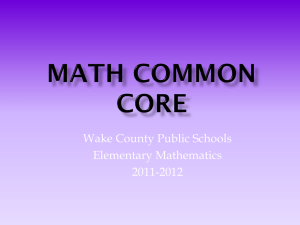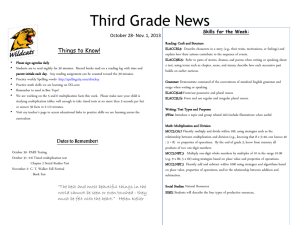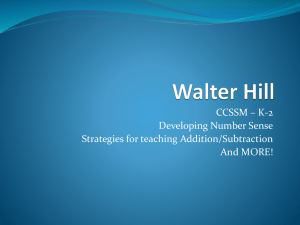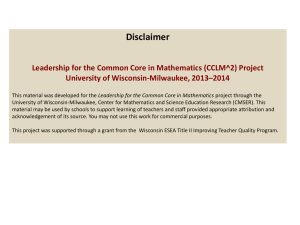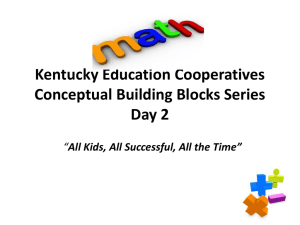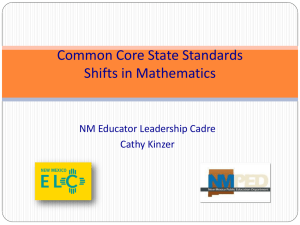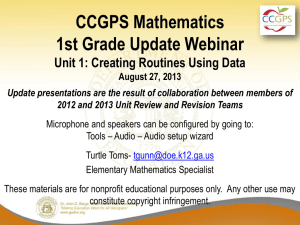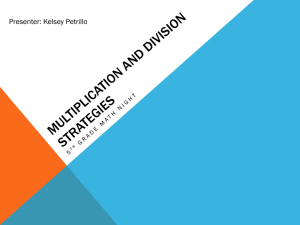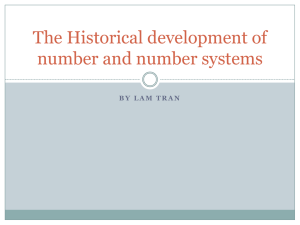Eric Milou`s K-6 Math Common Core PPT
advertisement
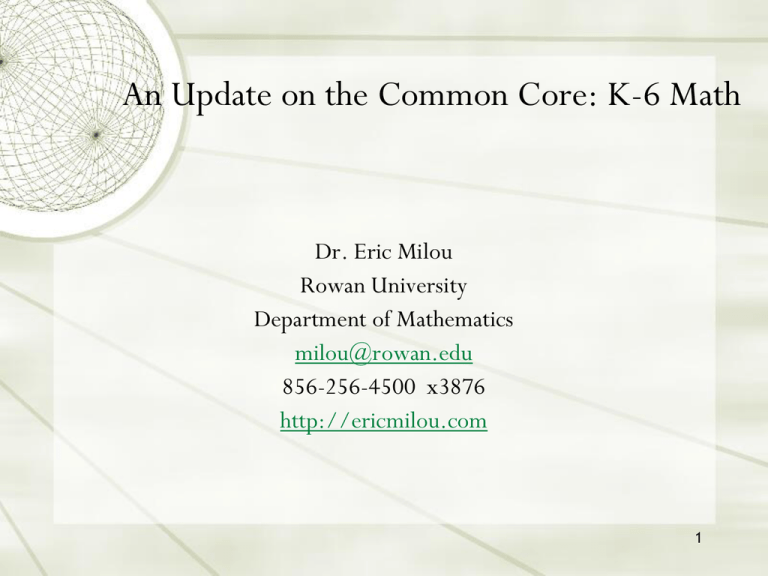
An Update on the Common Core: K-6 Math Dr. Eric Milou Rowan University Department of Mathematics milou@rowan.edu 856-256-4500 x3876 http://ericmilou.com 1 Preparing for the Common Core in 3 steps Know the content Standards, practices, and progressions Use Technology Engage, motivate, and assess Review Assessment Sample Items 2 Common Core State Standards: Let’s not just drink the Kool-Aid. Fewer, clearer, and higher, to best drive effective policy and practice; But definitely not fewer for grades 9-12! Clearer? Have you read these things? Aligned with college and work expectations, so that all students are prepared for success upon graduating from high school; Does math for college = math for work? Inclusive of rigorous content and application of knowledge through high- order skills, so that all students are prepared for the 21st century; Internationally benchmarked, so that all students are prepared for succeeding in our global economy and society; and Singapore. Singapore. Singapore. Research and evidence-based. The research they liked. 3 4 Implementation of the Common Core State Standards in New Jersey Adopted by NJ State Board June 16, 2010 http://www.corestandards.org Implementation Schedule: ELA 2011-2012 2012-2013 2013-2014 2014-2015 Mathematics K-2 K-12 3-5, HS 6-8 National Assessment National Assessments 2014-15 Partnership for Assessment of Readiness for College and Careers (PARCC) 19 states + DC, Achieve SMARTER Balanced Assessment Consortium (SBAC) 22 states, West Ed 3 states undecided, 1 (Utah) lost interest 5 states did not adopt the common core PARCC and SBAC PARCC & SBAC Online assessments for Grades 3-8 and high school Use of a mix of item types, including selected response, constructed response, technology enhanced and complex performance tasks. Two components, both given during final weeks of the school year. Use of both electronic and human scoring, with results expected within two weeks. 8 9 10 Three other consortiums www.k12center.org Dynamic Learning Maps (DLM) Significantly improve the academic outcomes of students with the most significant cognitive disabilities, thereby improving their preparedness for postsecondary options and the world of work. The assessment system will be designed to provide useful, timely diagnostic information and strong instructional support to teachers through a highly customizable system of instructionally embedded and end-of-year assessments. National Center and State Collaborative (NCSC) A comprehensive system that addresses the curriculum, instruction, and assessment needs of students with the most significant cognitive disabilities by: producing technically defensible summative assessments; incorporating evidence-based instruction and curriculum models; and developing comprehensive approaches to professional development delivered through state-level Communities of Practice. Assessment Services Supporting ELS through Technology Systems (ASSETS) The ASSETS Consortium will develop a next generation, technology-based language assessment system for students in grades K–12 who are learning 11 English. Sample Released items http://www.parcconline.org http://www.smarterbalanced.org Balanced Assessment Project http://balancedassessment.concord.org Mathematics Assessment Project (MAP) http://map.mathshell.org/ 12 Big Ideas Elementary K-2: Place Value & 10 Grades 3-5+: Fractions! Grades 6-8: Algebra High School: Modeling Modeling links classroom mathematics and statistics to everyday life, work, and decisionmaking. 13 14 The Importance of Ten 8 + 7 = ? How do we teach this? x x x x x x x x x x x x x x x x x 15 Best Friends 1 2 3 4 5 6 7 8 9 8+7=? 8 + 7=? 2 5 10 + 5 = 15 17 17 - 8 = 0 17 1/ 7/ -8 2 7 8 --> --> 10 --> --> --> --> --> --> --> 17 18 19 How Many Circles? 50 20 More time on computation but not the same old way Engaging & Active Arcademicskillbuilders.com Sumdog.com Less passive worksheets 21 The Influence of Video Games Unit Title Kindergarten Scope & pacing Pacing 1. Counting and Matching Numerals 0-5 with Comparing 2. Counting and Match Numerals 6-10 with Comparing Standards 4 weeks K.CC.1 K.CC.3 K.CC.4 K.CC.5 K.MD.3 K.CC.6 K.CC.7 3 weeks K.CC.1 K.CC.3 K.CC.4 K.CC.5 K.MD.3 K.CC.6 K.CC.7 3. Counting & Matching Numerals 11 - 20 4 weeks K.CC.1 K.CC.2 K.CC.3 K.CC.4 K.CC.5 4. Fluency with Add & Subt. within 5 4 weeks K.CC.1 K.CC.4 K.OA.2 K.CC.2 K.CC.5 K.OA.3 K.CC.3 K.OA.1 K.OA.5 5. Exploring Add & Subt. within 10 4 weeks K.CC.1 K.CC.4 K.CC.2 K.CC.5 K.CC.3 K.OA.1 6. Teen Numbers (11-19) & Counting to 100 4 weeks 7. Identify and Describe 2-D and 3-D Shapes 8. Compare, Analyze, and Compose 2-D and 3-D Shapes 9. Measurement by Direct Comparison 2 weeks K.OA.2 K.OA.3 K.OA.4 K.OA.5 K.CC.1 K.CC.2 K.CC.4 K.MD.3 K.G.1 K.G.2 K.CC.5 K.OA.1 K.NBT.1 K.G.3 K.G.4 K.G.5 2 weeks K.MD.2 K.G.1 K.G.2 K.G.3 K.G.6 K.G.4 K.G.5 4 weeks K.MD.1 K.MD.2 Grade 1 Unit Title Pacing Standards 1.OA.1 1.OA.2 1.OA.3 1.OA.4 1.OA.1 1.OA.2 1.OA.3 1.OA.4 1.OA.4 1.OA.8 1.OA.5 1.NBT.1 1.OA.5 1.MD.4 1.OA.7 1.OA.4 1.OA.8 1.OA.5 1.NBT.1 1.OA.5 1.MD.4 1.OA.7 1. Fluency with Addition and Subtraction within 10 5 weeks 2. Exploring Addition & Subtraction within 20 3 weeks 3. Counting and Place Value 5 weeks 1.NBT.1 1.NBT.3 1.MD.4 1.NBT.2 1.NBT.5 4. Exploring Addition & Subtraction within 100 5 weeks 1.OA.3 1.NBT.1 1.OA.5 1.NBT.2 1.OA.7 5. Defining Attributes of 2-D and 3-D Shapes 2 weeks 1.G.1 1.G.2 6. Partitioning Circles and Rectangles 2 weeks 1.G.3 7. Measuring Length with Non-Standard Units 2 weeks 1.MD.1 1.MD.2 8. Time to the Hour and Half-Hour 2 weeks 1.MD.3 1.G.3 1.NBT.4 1.NBT.6 Grade 2 Unit Title Pacing 1. Fact Strategies (+,-) Up to 20 2 weeks 2. Place Value to 1,000 4 weeks 3. Fluency with Addition & Subtraction within 100 4. Exploring Addition & Subtraction within 1000 5. Money 6. Reasoning with Shapes 7. Linear Measurement with Standard Units 8. Time to the Nearest 5-Minutes 9. Representing, Analyzing & Interpreting Data 10. Exploring Multiplication 3 weeks 3 weeks 3 weeks 2 weeks 3 weeks 2 weeks 2 weeks 2 weeks Standards 2.OA.1 2.OA.2 2.NBT.9 2.NBT.1 2.NBT.2 2.NBT.4 2.NBT.3 2.NBT.5 2.NBT.6 2.NBT.9 2.MD.5 2.NBT.1 2.MD.6 2.OA.1 2.NBT.8 2.NBT.9 2.NBT.1 2.NBT.7 2.MD.8 2.G.1 2.G.3 2.MD.1 2.MD.2 2.MD.3 2.MD.4 2.MD.7 2.NBT.2 2.G.3 2.OA.1 2.MD.9 2.MD.10 2.NBT.2 2.G.2 2.OA.3 2.OA.4 Unit Title 1. Understanding Multiplication and Division 2. Connecting and Using Multiplication and Division 3. Computing with Whole Numbers 4. Exploring Measurement and Data 5. Understanding Area and Perimeter 6. Reasoning about Two-dimensional Shapes 7. Understanding Fractions 8. Reasoning about Fraction Comparisons and Equivalence Grade 3 Pacing Pacing Standards 3 weeks 3.OA.1 3.OA.2 3.MD.3 5 weeks 3.OA.3 3.OA.6 3.OA.4 3.OA.7 3.OA.5 4 weeks 3.OA.7 3.NBT.1 3.OA.8 3.NBT.2 3.OA.9 3.NBT.3 3 weeks 3.MD.1 3.MD.2 3.MD.3 3.MD.4 4 weeks 3.MD.5 3.MD.6 3.MD.7 3.MD.8 3 weeks 3.MD.8 3.G.1 3.G.2 3 weeks 3.NF.1 3.NF.2 3 weeks 3.NF.3 3.G.2 3.NF - Assessment Item Which is closer to 1 on the number line, 4/5 or 5/4. Explain. This can be seen as a multi-step problem for grade 3: Compare 4/5 to 5/5 (like denominators) Compare 4/4 to 5/4 (like denominators) Compare 1/4 to 1/5 (like numerators) 3.NF.1 Pacing Guide – Grade 4 Unit Title Pacing Standards 1. Understanding and Using Place Value to Multiply and Divide 5 weeks 4.NBT.1 4.NBT.5 4.NBT.2 4.NBT.6 4.NBT.3 2. Factors and Multiples 2 weeks 4.OA.1 4.OA.4 4.OA.5 3. Multi-Digit Whole Number Computation 3 weeks 4. Comparing Fractions and Understanding Decimal Notation 4 weeks 5. Building Understanding of Addition, Subtraction, and Multiplication of Fractions 6. Solving Problems involving Measurement & Data 7. Exploring Angles and Angle Measurement 8. Understanding Properties of TwoDimensional Figures 4.OA.2 4.OA.3 4.NBT.4 4.NF.1 4.NF.6 4.NF.2 4.NF.7 4.NF.5 6 weeks 4.NF.3 4.NF.4 4.MD.4 3 weeks 4.MD.1 4.MD.2 4.MD.3 2 weeks 4.MD.5 4.MD.6 4.MD.7 3 weeks 4.0A.5 4.G.2 4.G.1 4.G.3 29 4.NBT.5 30 4.G.2 31 4.G.3 32 Pacing Guide – Grade 5 Grade 5 Pacing Guide Unit Title 1. Understanding the Place Value System 2. Computing with Whole Numbers and Decimals 3. Algebraic Connections 4. Addition and Subtraction of Fractions 5. Making Sense of Multiplication of Fractions 6. Understanding Division of a Unit Fraction and a Whole Number 7. Classifying 2-Dimensional Figures 8. Exploring Volumes of Solid Figures Pacing Standards 4 weeks 5.NBT.1 5.NBT.2 5.NBT.3 3 weeks 5.NBT.5 5.NBT.6 5.NBT.7 3 weeks 5.OA.1 5.OA.2 5.OA.3 4 weeks 5.NF.1 5.NF.2 5.MD.2 4 weeks 5.NF.3 5.NF.4 5.NF.5 5.NF.6 3 weeks 5.NF.7 3 weeks 5.G.3 5.G.4 4 weeks 5.MD.3 5.MD.4 5.MD.5 5.G.1 5.G.2 33 5.NF.4 and 6 34 5.G.3 and 4 35 5.NF.5 36 Grade 3 Fractions Summary Develop understanding of fractions as numbers. Grade 4 Extend understanding of fraction equivalence and ordering. Build fractions from unit fractions by applying and extending previous understandings of operations on whole numbers. Understand decimal notation for fractions, and compare decimal fractions. Grade 5 Use equivalent fractions as a strategy to add and subtract fractions. Apply and extend previous understandings of multiplication and division to multiply and divide fractions. Grade 6 Apply and extend previous understandings of multiplication and division to divide fractions by fractions. Compute fluently with multi-digit numbers and find common factors and multiples. Apply and extend previous understandings of numbers to the system of 37 rational numbers. Number Line Task a-b b-a 0 a+b a b Where is a+b on the number line? Where is b-a? Where is a-b? What about (a/b)? (Need to know where 1 is.) 38 How Much Space? Janie’s Ipod holds 10 Mb of music. Janie downloaded songs that were 2 Mbs. How many songs can she fit on her Ipod? Richard also has an Ipod that holds 10 Mb of music. He downloaded shorter songs that were only ½ Mb. How many songs can he fit on his Ipod? Picture of 10 ÷ ½ |--------------------- 10 MB---------------------| Grade 6 Content & Pacing Grade 6 Pacing Guide Unit Title 1. Using Expressions and Equations 2. Operating with Positive Rational Numbers 3. Understanding Positive & Negative Numbers 4. Applications of Geometry Pacing 4 weeks 4 weeks 2 weeks 3 weeks 5. Ratios and Rates 3 weeks 6. Algebraic Reasoning 5 weeks 7. Statistics and Distribution 5 weeks Standards 6.EE.1 6.EE.2 6.EE.3 6.EE.4 6.NS.1 6.NS.2 6.NS.3 6.NS.4 6.G.2 6.NS.5 6.NS.6 6.NS.7 6.NS.8 6.E E.5 6.EE.6 6.EE.7 6.E E.8 6.G.1 6.G.3 6.G.4 6.RP.1 6.RP.2 6.RP.3 6.EE.6 6.EE.7 6.EE.9 6.SP.1 6.SP.2 6.SP.3 6.SP.4 6.SP.5 42 Grade 6: EE, CR Grade 6: EE, TE Fact #1 A 45 Fact #2 B 46 Fact #3 C 47 Fact #4 D 48 Fact #5 E 49 Fact #6 F 50 Fact #7 G 51 Fact #8 H 52 Fact #9 I 53 What is this? 54 What is this? F A C E 55 What If? A B C D E F G H I 56 Try Again 57 Try Again DECA D E 58 What’s the Point? Do NOT: Isolate Skills Do: Connect mathematics Model mathematics Engage students with Technology 59 http://ericmilou.com/ 60 Things to Consider in Summary Is modeling and contexts a part of daily instruction? Depth of content especially fractions in grades 3-6 Use of technology to engage, motivate, and assess Be wary of extraneous context 61 Thank You Dr. Eric Milou Rowan University milou@rowan.edu http://ericmilou.com/ 62
